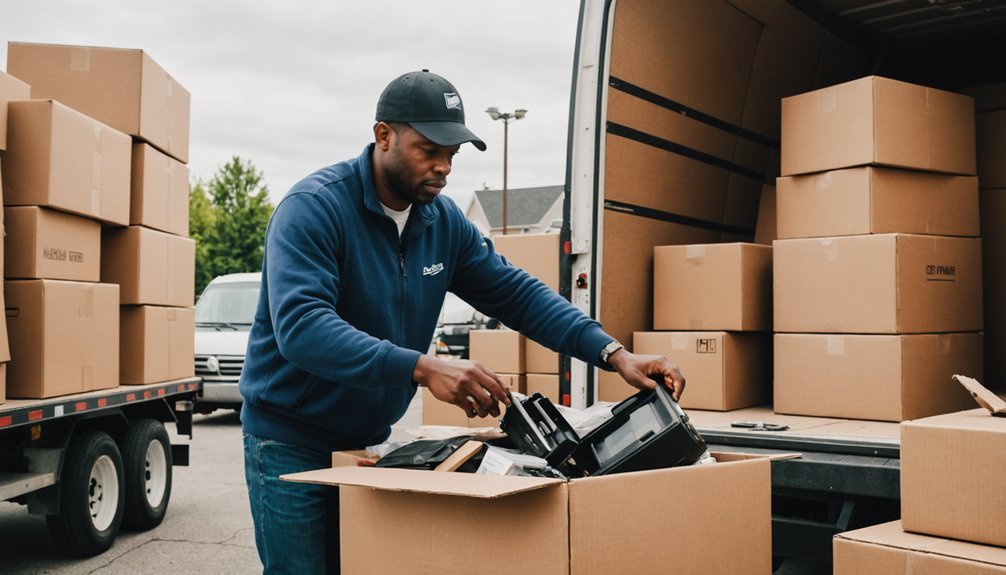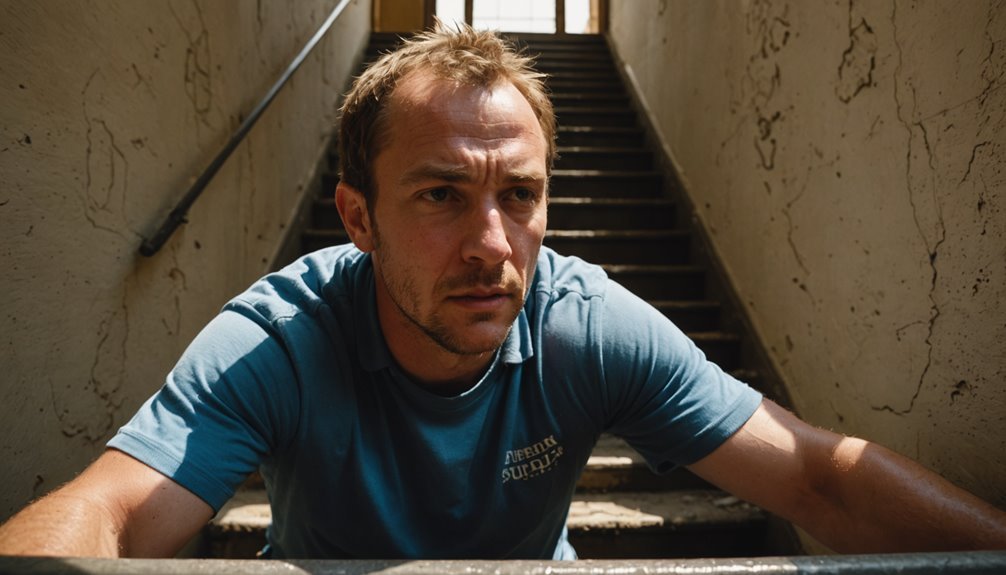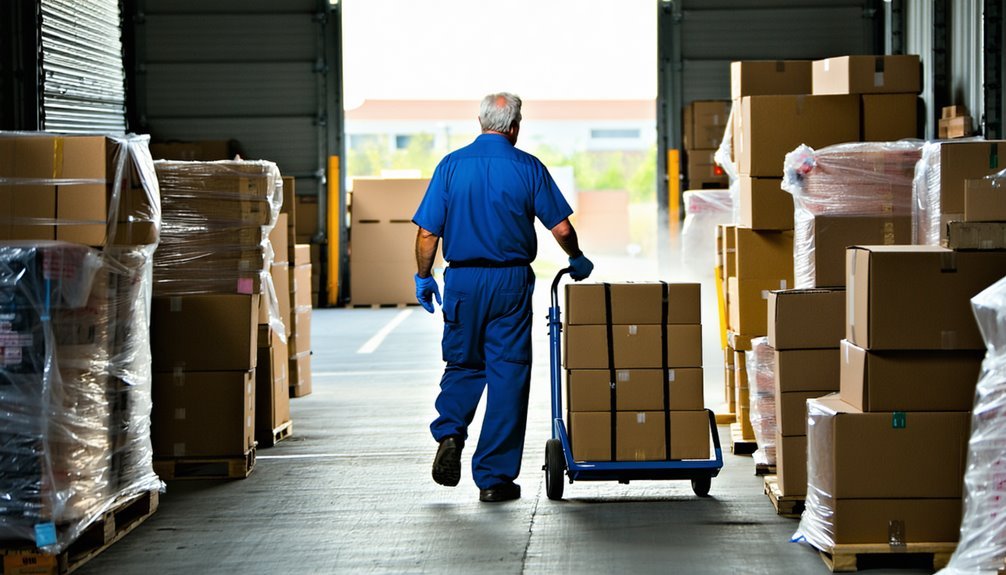Imagine you're waking up while the city still sleeps, gearing up for a day that's as physically demanding as it is meticulous. As a professional mover, your mornings start with a strategic briefing, where you and your team map out the day ahead. You'll find yourself maneuvering through tight corridors and packing fragile items with precision, ensuring everything is secure for transit. Each client interaction requires diplomacy and attention to detail—skills that are as vital as your physical strength. But what happens when things don't go as planned? Stick around to uncover how unexpected challenges are met with quick-thinking and expertise.
Key Takeaways
- Movers start early, often before sunrise, to prepare for the day's physical tasks and strategic planning.
- Daily briefings at the base cover the schedule, logistics, and team assignments based on individual strengths.
- On-site, movers assess each space to devise specific plans for handling heavy and delicate items.
- Throughout the move, continuous communication with clients ensures preferences are met and concerns addressed.
- Teams employ specialized packing and loading techniques to safeguard items and optimize truck space.
Morning Preparation Routines
Professional movers begin their day long before the sun rises, ensuring they're ready for the day's physical demands. You're up with the stars, prepping your mind and body for the intense physical labor ahead. It's not just about strength; it's about smart work. Your morning preparation routines set the tone for the day.
By dawn, you're at the base, where the team gathers for an essential briefing. Here, you're not just absorbing the day's schedule, but you're also engaging your problem-solving skills. You'll anticipate challenges, strategize logistics, and allocate tasks based on each member's strengths. This attention to detail in planning is what differentiates a smooth move from a chaotic one.
Next, it's time to check and load the trucks. You meticulously inspect each packing tool and piece of equipment. The packing materials—boxes, tape, padding—are not just loaded, but carefully organized for easy access upon arrival.
Securing these items in the truck requires a technique that prevents shifting and damage during loading and transportation. It's a skill honed by experience, ensuring everything arrives in the same condition it left. This meticulous approach minimizes risks and maximizes efficiency, setting the stage for a successful move.
On-site Operations and Strategies
Arriving early at the client's location, movers quickly assess the space to devise a tailor-made plan that guarantees an efficient packing and loading process.
As part of your day in the life of a mover, you'll experience the core of professional moving services, which hinges on meticulous planning and seamless moving. Each room is scrutinized to understand the best approach for moving furniture and boxes, especially when dealing with heavy items.
Effective communication with the client is essential. You need to grasp their preferences and expectations, making certain a moving process that's as stress-free as possible for them.
Here's a quick look at what makes this stage effective:
- Communication: Engaging with the client to confirm details and understand special requirements.
- Teamwork: Coordinating with your team to tackle obstacles like narrow passages or adverse weather.
- Protection and Safety: Employing careful handling and smart loading strategies to prevent damage and guarantee safety.
Throughout these operations, teamwork among movers is significant. You rely on each other to navigate challenges efficiently, enhancing the professional service you provide.
This phase is demanding but rewarding, as you play a pivotal role in helping clients move smoothly to their new homes.
Packing and Loading Techniques

Once everything is sorted and prepped, it's time to plunge into packing and loading. As a professional mover, you know that guaranteeing everything arrives intact is paramount.
Start by wrapping fragile items in bubble wrap and packing paper, taking special care to minimize the risk of breakage. Clearly label each box with its contents and which room it's destined for, simplifying the unpacking process at your next move.
When it comes to the truck, heavier items are your foundation. Load these first, placing them at the bottom to maintain balance and prevent any shifting during transit. This strategy is essential, especially when you're figuring out how to get large furniture to fit securely.
Next, protect your furniture with moving blankets and pads before strapping them down. This prevents scratches and damage, keeping each piece in showroom condition.
Don't forget to fill any empty spaces in the boxes with additional packing materials to keep the contents stable. This attention to detail guarantees that everything stays exactly where you placed it, no matter the bumps along the way.
Client Interaction and Relations
After guaranteeing that every item is safely packed and loaded, attention shifts to maintaining clear and effective communication with you, the client. This part of our job is essential in helping people feel at ease during what can be a stressful time.
As professional movers, we're committed to providing you with a tailored moving experience that meets your specific needs and preferences.
- Clear Communication: We keep you updated with regular checks and updates. This makes sure that you're always in the loop, from the initial loading to the final unloading.
- Trust and Confidence: By addressing your concerns about item safety and timing upfront, we foster a relationship based on trust. We provide estimates and realistic timelines to set the right expectations.
- Responsive Customer Service: Our job doesn't end when your belongings reach their destination. We offer tips for settling in and remain available to answer any questions. After the move, we seek your feedback to improve our services and confirm your satisfaction.
These interactions aren't just about moving items; they're about moving lives. Your trust and confidence in our abilities are what drive us to excel in customer service every day.
Challenges and Problem-Solving

Steering through the unpredictable elements of a move requires skill and adaptability. As a professional mover, you'll find that the challenges you face demand quick thinking and innovative solutions.
Whether it's maneuvering narrow staircases or guiding through tight hallways, movers are trained to tackle these problems on the spot. You'll need to be resourceful, sometimes disassembling large furniture to fit through cramped spaces or devising new paths when faced with unexpected road closures.
Weather adds another layer of complexity. Rain or extreme heat can slow down a move, requiring you to adapt your methods to keep everything on track while ensuring the safety of your team and the items you're transporting.
It's not just about hard work; it's about smart work and maintaining composure under pressure.
Teamwork is your greatest asset. You and your crew must communicate effectively, working together to handle heavy or awkward items safely.
It's about more than just muscle; it's strategic planning and collaborative effort, especially when you're dealing with busy streets and other logistic hurdles.
Each move teaches you new strategies and strengthens your ability to think and act swiftly, ensuring client satisfaction and safety every step of the way.
Wrap-Up and Reflection
Wrapping up a day's work, professional movers meticulously unload and place each item as the client requests, guaranteeing that every piece finds its rightful place.
After everything is arranged in the new home, you conduct final checks to confirm the client is satisfied, addressing any concerns to go the extra mile to secure their happiness. You also take a moment to share some helpful home improvement tips and ideas tailored to the client’s preferences, offering suggestions that can enhance their living space even further. This personal touch not only leaves a lasting impression but also demonstrates your commitment to their long-term satisfaction. By the time the process is complete, the client feels confident and excited about starting this new chapter in their beautifully arranged home.
As you load the remaining equipment back into the truck, you reflect on the day's set of challenges and the satisfaction derived from overcoming them.
Each move brings unique obstacles, but your ability to adapt and resolve issues swiftly defines the quality of service your moving company provides.
Here are key takeaways from today's experiences:
- Client Satisfaction: Guaranteeing all items are correctly placed and clients are happy with the move.
- Efficiency and Organization: Properly loading equipment post-job to prepare for the next day.
- Pride in Work: The fulfillment from helping families start a new chapter in their lives.
This reflection isn't just about today; it's about your life as a mover, constantly evolving and working to provide the best experience.
It's these moments of reflection that remind you why you chose this career path.
Frequently Asked Questions
What Do I Do While Movers Are Working?
While movers handle your belongings, stay available for any questions to guarantee proper furniture protection and adherence to your packing tips.
Secure your pets and maintain clear communication about valuable items for safety and efficiency.
Organize essential items in a specific area for easy access post-move.
Keep track of scheduling logistics and use this time for stress management, perhaps by planning the layout of your new space to streamline the unpacking process.
What Is a Mover Job Description?
As a mover, your job involves packing, loading, transporting, and unloading items for clients.
You'll handle equipment, follow safety protocols, and interact with customers to guarantee a smooth move.
Your daily tasks require physical strength and problem-solving skills, especially in challenging work environments.
Mover responsibilities also include adapting to on-the-spot changes and working collaboratively.
Salary expectations vary based on experience and location, reflecting the demanding nature of the job.
Does Being a Mover Make You Strong?
Yes, being a mover likely makes you strong.
You'll face daily challenges that boost your physical endurance and muscle development.
Mastering lifting techniques and working closely in teamwork dynamics not only enhances strength but also aids in injury prevention.
Plus, the physicality of the job contributes to both job satisfaction and a noticeable increase in your fitness levels.
Who Is a Professional Mover?
A professional mover is someone who specializes in relocating items safely and efficiently.
You're trained in various moving techniques, packing strategies, and equipment handling. Interacting with customers, you guarantee their belongings are secure, adhering to safety protocols.
Despite industry challenges like tight spaces or adverse weather, you maintain professionalism.
This role offers opportunities for career progression, developing skills in logistics and customer service, making it a dynamic and essential profession.
Conclusion
As you've seen, a mover's day is far from simple. From the early morning strategy sessions to the careful handling of each item, your dedication guarantees smooth shifts for every client. Today's challenges required quick thinking and teamwork, showing just how vital your role is in easing the stress of moving. So, take a moment to reflect on the job well done and prepare for tomorrow's adventures. Your hard work doesn't go unnoticed.


